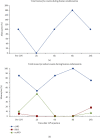Participation of Monocyte Subpopulations in Progression of Experimental Endotoxemia (EE) and Systemic Inflammation
- PMID: 33628841
- PMCID: PMC7895567
- DOI: 10.1155/2021/1762584
Participation of Monocyte Subpopulations in Progression of Experimental Endotoxemia (EE) and Systemic Inflammation
Abstract
Systemic inflammation plays a crucial role in formation of various pathological conditions, including sepsis, burns, and traumas. The main effector cells participating in progression of systemic inflammation response and sepsis are monocytes, which regulate both innate and acquired immunity via phagocytosis, synthesis of cytokines and chemokines, antigen presentation, and lymphocyte activation. Thus, the monocytes are considered as a link between innate and acquired immunity. The monocyte subpopulations taken into consideration in the study essentially determine the progression of systemic inflammation and could serve as targets for therapeutic intervention. The complexity of the analysis of pathophysiology of systemic inflammation lies in its high variability conditioned by individual peculiarities of the patients and inflammation progression specifications. To overcome these limitation, model of experimental endotoxemia (EE) is used. The results of EE, in turn, cannot be directly extrapolated on patients with the systemic inflammatory response. This review is dedicated to discussing the role of monocyte subpopulations in progression of systemic inflammation/sepsis and EE.
Copyright © 2021 Yaroslav V. Radzyukevich et al.
Conflict of interest statement
The authors declare that they have no conflicts of interest.
Figures



Similar articles
-
Experimental human endotoxemia as a model of systemic inflammation.Biochimie. 2019 Apr;159:99-106. doi: 10.1016/j.biochi.2018.06.014. Epub 2018 Jun 22. Biochimie. 2019. PMID: 29936295 Review.
-
Monocyte Subsets Are Differentially Lost from the Circulation during Acute Inflammation Induced by Human Experimental Endotoxemia.J Innate Immun. 2017;9(5):464-474. doi: 10.1159/000475665. Epub 2017 Jun 23. J Innate Immun. 2017. PMID: 28641299 Free PMC article.
-
Gal3 Plays a Deleterious Role in a Mouse Model of Endotoxemia.Int J Mol Sci. 2022 Jan 21;23(3):1170. doi: 10.3390/ijms23031170. Int J Mol Sci. 2022. PMID: 35163089 Free PMC article.
-
Role of Metabolic Endotoxemia in Systemic Inflammation and Potential Interventions.Front Immunol. 2021 Jan 11;11:594150. doi: 10.3389/fimmu.2020.594150. eCollection 2020. Front Immunol. 2021. PMID: 33505393 Free PMC article. Review.
-
Pro-Inflammatory Th1 and Th17 Cells Are Suppressed During Human Experimental Endotoxemia Whereas Anti-Inflammatory IL-10 Producing T-Cells Are Unaffected.Front Immunol. 2018 May 18;9:1133. doi: 10.3389/fimmu.2018.01133. eCollection 2018. Front Immunol. 2018. PMID: 29868038 Free PMC article.
Cited by
-
Prospective flow cytometry analysis of leucocyte subsets in critically ill patients who develop sepsis: a pilot study.Infection. 2023 Oct;51(5):1305-1317. doi: 10.1007/s15010-023-01983-3. Epub 2023 Jan 25. Infection. 2023. PMID: 36696043
-
Prediction of outcome using CD14++CD16-, CD14++CD16+ and CD14+CD16++ monocyte subpopulations in patients with complicated intra-abdominal infections.Med Microbiol Immunol. 2023 Oct;212(5):381-390. doi: 10.1007/s00430-023-00779-4. Epub 2023 Sep 8. Med Microbiol Immunol. 2023. PMID: 37682398
-
Recent Insights Into the Role of Macrophages in Acute Gout.Front Immunol. 2022 Jul 8;13:955806. doi: 10.3389/fimmu.2022.955806. eCollection 2022. Front Immunol. 2022. PMID: 35874765 Free PMC article. Review.
-
Disease Activity-Dependent Siglec-1 Expression on Monocyte Subsets of Patients with Idiopathic Inflammatory Myopathies.Int J Mol Sci. 2025 May 21;26(10):4950. doi: 10.3390/ijms26104950. Int J Mol Sci. 2025. PMID: 40430089 Free PMC article.
-
Enriched dietary saturated fatty acids induce trained immunity via ceramide production that enhances severity of endotoxemia and clearance of infection.Elife. 2022 Oct 20;11:e76744. doi: 10.7554/eLife.76744. Elife. 2022. PMID: 36264059 Free PMC article.
References
-
- Chakraborty R. K., Burns B. Systemic Inflammatory Response Syndrome //StatPearls [Internet] Treasure Island (FL): StatPearls Publishing; 2020. - PubMed
Publication types
MeSH terms
Substances
LinkOut - more resources
Full Text Sources
Other Literature Sources

